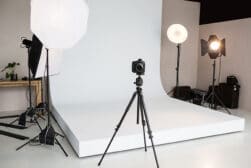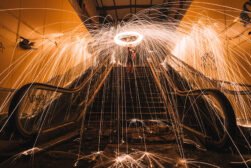
How To Use Window Light in Your Photography (9 Pro Tips)
If you can find beautifully soft window light for your next portrait or product photoshoot, count yourself lucky. Here's how to make the most of it.
By Jeff Collier
Taking gorgeous portraits does not always require expensive lighting equipment, especially when you have plenty of window light available.
In this article, you’ll learn how to create eye-catching portraits using a nice window where plenty of light enters the space creating the perfect illumination from window light for your subject.
I have been taking great portraits for many years, and one of my favorite methods is using window light.
Here are some great tips I have discovered on how to use the natural light and direct sunlight available through a single window effectively when taking photos.
You can also start with our guide to photography lighting techniques for an overview.
What is Window Light in Photography?
Window light photography is a method used by photographers to shoot great portraits using direct sunlight streaming into a room through a window.
Shooting a window light portrait can create stunning images with a soft, dreamy glow about them.
Window light acts similarly to a softbox, and shooting methods are relatively the same, but window light is much better.
It is important to remember the larger the window, the softer the light is.
For example, using window lighting from a large window for great portraits allows a wider angle of light to fall on the face, creating fewer shadows and a softer look.
How Do You Take a Picture With Window Light?

Credit: Tima Miroshnichenko
Natural lighting is one of the most versatile and flattering light sources for photography shoots.
Window light can create looks from soft portraits to moody appearances with harsh, heavy shadows.
No matter what your photography lighting needs are, window light can accommodate your every need.
Here are some tips to enhance your window light photography in 2023:
Not All Windows Are Created Equal
As discussed above, large windows create a softer look, while smaller ones can cast distinctive shadows and create a harsher look in photographs.
Additionally, windows facing north or south provide more consistent, even lighting, while windows facing east or west will have direct sunlight in the morning or evening, which is best for more dramatic images.
Use a Reflector
To help distribute the light source coming through the window more evenly, use a reflector, which can also help soften harsh shadows that fall on your subject.
A reflector can also guide the light from the window to your subject, giving you more control over the light and how it illuminates your subject.
If you don’t have a photography reflector available, a sheet of white paper can help bounce the light source in a similar manner.
Use Manual Focus
To help compensate for the camera’s challenges focusing when shooting in dark or high contrast situations, use the camera’s manual focus setting.
Manual focus allows you to control the focus and lessens the chances of having a fantastic photo, only to find it is a bit out of focus during post-processing.
Find the Best Position
Where you place your subject during the photoshoot in relation to the window can significantly impact the image results.
Take time to play around with different positions to create a dramatic look, or find the perfect one to create your desired look.
Some positioning examples may include:
- Closer to the window for more contrast
- A few feet away from the window for a more even look
- Place the subject’s side to the window creates a dramatic fall of light on the opposite side – see these side lighting photography tips.
- Silhouettes appear when the window is behind the subject
- Balance the ambient light by deliberately placing your model in a position near a window and another light source
Use Blinds or Shades
Blinds and shades can help control the amount of light coming into a room, which gives you complete control over how much light shines onto your subject.
A simple adjustment of the blinds or shades can help reduce the light coming in through the window and create interesting lines, shapes, and deep shadows that fall upon your subject.
Work Fast
Whether you are using a south-facing window or one facing another direction, the light coming in through the windows can quickly change, creating a flat light, softer light, or a harder light at a moment’s notice.
As a natural light photographer, you’ll quickly discover rarely light remains consistent.
Everything from the moving sun to clouds rolling in can affect the natural light streaming into your space when shooting window light portraits.
Best Window Photography Settings
In addition to having the most natural light flooding your subjects, using the best camera settings can help make the portraits much more stunning.
The best camera settings for window light photography include:
- File format: Raw
- Exposure mode: Aperture-priority
- Aperture: Wide aperture (f/2.8 or wider)
- ISO: High ISO (800+)
- Shutter speed: 1/125 seconds or faster
- Focus mode: Single-servo
- Drive mode: Single shot
- Auto white balance
If the window light is likely to be changing constantly during your shoot, you can also shoot in manual mode.
This way, you can keep adjusting your aperture and shutter speed to compensate for the light instead of relying on aperture priority.
How Do You Fake Window Light in Photography?
Window light photography creates beautiful, impressive images using the light source through a room’s windows.
However, what happens when you want the look of window light photography but do not have the perfect window accessible for your photoshoot? Then, you create a faux window.
There are several ways to replicate the light source look from windows without having windows. Some of those methods are below:
Replicate Window Light
One of the best things about window light photography is natural light; however, when you do not have a window, you must do your best to create this lighting look using other light sources and techniques.
Some ways to create or replicate the window light for indoor photography without a window may include:
- Use studio lights with natural light diffusers
- Use multiple light sources
- Use mirrors to reflect and bounce light around the room and create soft shadows
- Use a warm light with yellow hues
- Take photos in a room with white or off-white walls
- Use a light dimmer to control shadows
- Hang sheer curtains between the light and the subject
- Avoid using lampshades with patterns
See also: how to set up a home photography studio
Faux Window Effects
If you do not have a window, but want the exact effects of shooting with one, consider making a small fake window to use during your photoshoot.
Make a frame resembling a window using wood or cardboard, but ensure there are crisp lines that closely resemble an authentic window.
Place the faux window between your subject and the light to create window-like shadows on your subject’s face or into the room.
If you want more unique window-like features, add blinds, curtains, or shades to your faux window and use them to create fun shadows on your subject. Don’t forget to add window panes to your faux windows.
To get the best look possible, play around with the height and position of the lighting in relation to the faux window and your subject, including creating the perfect shadow.
What Are Some Window Lighting Photography Ideas?
Window light photography allows you to get as creative as possible while using outside light to illuminate your subject.
There are all kinds of window light photography, including portrait photography and still life creative photos, and each one is unique based on the way the light from the window falls onto the subject.
As long as you can find a window and get your subject in front of it, you are sure to create a beautiful image.
Here are some fun window light photography ideas you can quickly try:
Waves of Light

Credit: Cottonbro Studio
Take great portraits of your subject using blinds in the windows to create slatted shadows on your subject’s face, similar to waves of light falling over your subject.
Backlight Glow

Credit: Andrea Piacquadio
When the soft light coming in through the window is not too harsh, set your subject in front of it to create a warm glow around them.
Backlighting can create a soft glow, or halo, around a person, which can also illuminate and make their hair look softer.
Backlighting can create a soft glow around the flower’s petals when shooting still life, especially flowers.
Silhouettes

Credit: Zafer Erdoğan
When the direct light coming in through the window is at its brightest, set your subject in front of the light to create a dramatic silhouette with your photography. Thsi won’t wok as well with a smaller window, so choose wisely.
Black Background

Credit: Zaid Mohammed
Use black sheets behind your subject and have the light coming toward them from the side, creating harsh shadows falling on your subject’s opposite side.
This can create a very artistic image and beautiful portraits. Who would have thought that you could create such dramatic portraits using window light?
Eye-Catching Reflections

Credit: Victor Freitas
Place your subject facing the window light or light source, also known as front lighting, and capture the reflection of the window in your subject’s eyes for a beautiful portrait.
Day Dreaming

Credit: Ekaterina Bolovtsova
Place your subject closer to the window with direct sunlight coming in and have them look out off into the distance.
Take photos of your subject as if they are daydreaming and if you are shooting in front of larger windows try to maximize the use of the setting outside the window.
Plant Shadows

Credit: Cottonbro Studio
For gorgeous images with amazing shadows, place a large-leafed plant, between the window and your subject.
Shooting in front of a west-facing window can create softer-looking light and cast soft shadows on your subject for an amazing portrait.


Check out these 8 essential tools to help you succeed as a professional photographer.
Includes limited-time discounts.














